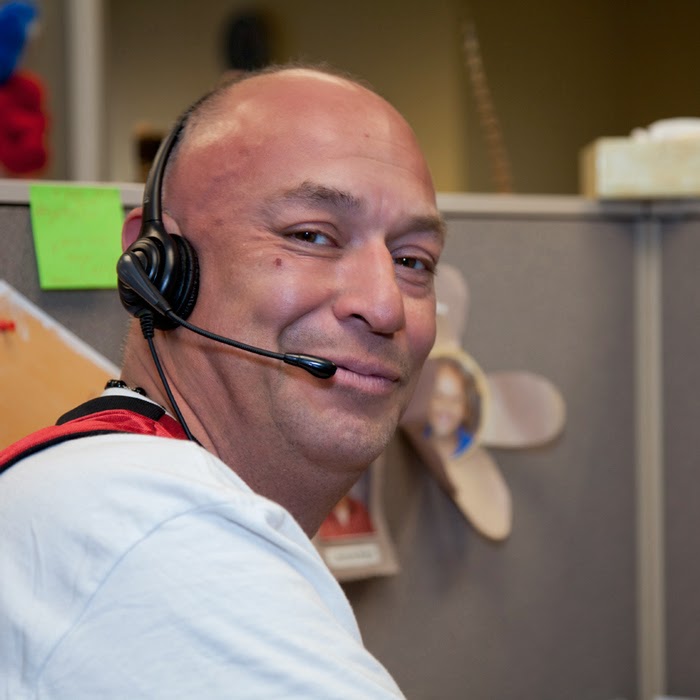The first thing I notice about the nondescript two-story
brick building is the sign. Or, to be more precise, the wrong sign. I’m looking
for Professional Placement Services (PPS). I check the address again. I’m at
the corner of 12th and Mount Vernon and number on the building
matches. But I see only “Signarama” in bright red lettering. I wonder how much
privacy a collection agency needs.
After confirming that I’m in the correct building the second
thing I notice are the locks on the doors. In the main lobby I press the call
button, identify myself and hear the familiar click of a lock disengaging. On
the second floor I find myself in a glass cage confronted by another locked
door and another call button. This time when I push it there is no answer.
Immediately beyond the glass cage is a vacant reception desk. I tap on the
glass, gingerly. To the concern for privacy add security.
The next thing I notice contradicts everything I’ve been
seeing. Before long I am admitted and introduced to Craig, co-owner, with his
wife Irina, of PPS. Craig’s face lights up with a genuineness that is disarming.
His bright smile and warm greeting dispel the cloak and dagger aura evoked by
the anonymous, locked-down facility.
 |
| Irina and Craig |
PPS is a successful and growing business with 40 employees
and 180 clients. “We’re experts in collection,” Craig says. “Our clients want
to outsource collection activities to the experts.” Their clients include local
and national retailers, banks, health care companies and various levels of government.
And, yes, I’m told fervently, security is one of the primary concerns. The
locked doors—and the surveillance cameras I hadn’t even noticed—are intended to
protect the privacy of client businesses and debt-laden consumers alike.
I confess ignorance about the business of collection. Craig,
who hears this all the time, is energized. The company makes 35,000 calls a
day, he tells me. “We want to help people get out of debt. Our big message is, ‘Communicate
with us’.” Clearly relishing the subject, he elaborates, “Some people have an
image of us as the collector at the door with a baseball bat. We work hard to
change that.” Their primary goal, he says, is to enable people to manage their
finances. In a soft, compassionate tone he suggests, “Everyone goes through
times that are tough. We want to understand the situation and work with them.”
Debt collection, says Craig, is important to the economy and
the local community. “It's the
backbone of a credit-based economy. The money we collect helps keep businesses
operating, helps owners make payroll and provide benefits, helps to keep people
employed. It also helps government avoid tax increases.”
When I ask why they located their business in the Menomonee
Valley I am graced with another of Craig’s ingenuous smiles. He and Irina moved
the company from the Third Ward to the Valley in 2008. He ticks off the
advantages of the new location: its central location, proximity to bus lines,
available parking, nearby eateries for lunch. “The Menomonee Valley is a great
place for a company like us to start and grow.” In fact, PPS has tripled in
size since its move to the Valley and could add 50-100 new employees in the
next couple years, he declares confidently.
The Menomonee Valley is also in what is known in the collection
industry as a Hub Zone. This is a federal designation that identifies places in
need of revitalization. Being in the Valley qualifies PPS to offer its services
to the federal government, a distinct advantage. It is one of the reasons that
Craig and Irina chose not only to locate here but also to invest in the Valley
by purchasing the property with expansion in mind.
Craig’s interest in the Valley goes beyond the material
benefits to his business of the location, however. The disparity of our
personal experiences begins to resolve into greater harmony as he asserts, “The
whole story of the Valley is great. It went from swampland to the manufacturing
age and now it’s turning another corner. You can see new businesses…and you see
trout and salmon. There are fishermen in the river. Just a few short years ago
you wouldn’t have seen that.”
I meet Irina, who is a brisk and businesslike foil to
Craig’s gregariousness. “I’m the boss,” she says right off. I glance towards
Craig. “He knows I’m the boss,” she adds with a smile. They have an infectious
natural affinity as well as a mutual regard for their business. “We’ve been
excited about the company for many years,” she says enthusiastically. Then
Craig adds something I never expected to hear about a collection agency: “It’s
a fun business!” I’m inclined to
skepticism but Craig’s enthusiastic demeanor evaporates my doubt.
As I gather up my camera gear and head for the door Craig
offers parting advice: “If you should ever get a call from us, talk to us!” He grins as he holds open
the door for me.
Let me introduce a few of the PPS staff. Because privacy is
in fact a genuine concern I am using only their first names.
 |
| Roberto, Account Representative |
 |
| Ann, Account Representative |
 |
| Dan, operations manager, with Craig |
 |
| Jenaya, Account Representative |
 |
| Josh, Account Representative |
 |
| Jeff, Assistant Collection Manager |
This post is one in a series that relates to my Menomonee Valley Artist in Residency. For more information about the residency and links to previous posts and photographs, go to MV AiR.
















